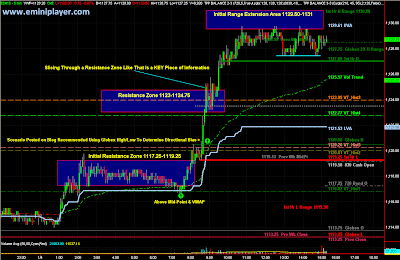A question I'm frequently asked on the Blog is, "how do you enter the trade once price reaches your Key Area of Support/Resistance", or what "setups" I look for. Before I answer this question, I just want to put out the disclaimer that I'm in the learning stage myself, and what works for me, may not work for you.
The nightly preparation where I define the Key Levels to do business are an essential part of the setup. The chart I post every night is my Road Map for the following day, and even though I
could trade without it, I would feel a little lost without the nightly preparation work. I already have scenarios in mind before price ever reaches those areas, and the scenarios are constantly being tweaked based on the latest market-generated information (price/volume). For example, if price reaches an Area of Resistance, my expectation is Rotation or a Pullback. Will price pull back 2 points, 5 points, or 20 points? I honestly don't know how much it will pullback, or whether it will pullback at all. But I anticipate enough of a pullback to allow me to move my stop-loss to break-even (
generally stop is moved to break-even once price goes +6 ticks in my direction). Once price reaches my "pre-defined" Key Area, I don't have any specific "setup" -- all I look for is price to stall for a moment, and I'm in. If I hesitate, analyze or start looking for an elaborate "setup", price WILL move away from my ideal entry price, and I'll have to use a wider stop-loss to enter the trade (unacceptable to me). I am not an aggressive trader and I hate taking heat on my trades. I'm not trying to nail the top or bottom of the day, but I do try to nail the top or bottom of the current swing. I don't mind scratching trades because even my retail commissions are fairly low. Eventually I will either be working at a prop firm with member rates or will lease a seat at the CME, so I'm not worried about commissions.
ES 233 tick-bar Chart (Execution Chart)
I'll use a trade from Friday as an example and walk you through how
little went through my mind when I entered this trade. The 233 tick-bar chart above illustrates the Trade. 1066.25-1068.75 was a pre-defined area of Support off the
Key Levels chart posted the night before, so as soon as price reached that "area", I began looking for a Long opportunity off the 233 tick-bar chart (execution chart). Price built a small base at 1067.50, and I pulled up the DOM to execute the trade. I entered Long at 1068.25 when I saw the offers being lifted at 1068.25 -- I want my order to be one of the last few that gets executed at that price. That's all I looked at; and that was my "setup". Price quickly moved away from my entry and began building a base in the 1069.25-1069.75 area, and I moved my stop-loss to break-even (stress-free position now). Immediate resistance was the Globex Low at 1070.50, and I scaled ahead of that at 1070.25. 1074.75-1075.00 was stronger Resistance based on the 5-minute chart, and the final target should be around that Level. Once price broke above 1070.50, immediate resistance became immediate support, and the stop-loss was moved to 1070.25, locking in +2 points on the remaining position. Price moved up again and began building a base in the 1073.00-1073.50 area, and I scaled at 1073.25 because I didn't
know whether price would base and move up, or rotate down. An important point to keep in mind is that,
I don't know what's going to happen next, so I must manage the trade based on the information I do have. Price then pulled back to 1071.25, just one point away from my stop-loss. When price shot back up to 1074, and began building a base at 1073.25, I exited the position completely at 1073.25 due to the time of day (2:44 PM cst, nearing market close). The final target was 1074.25, ahead of that 1074.75-1075.00 Area of Resistance.
The main point to take away from this post is that I don't look for any elaborate "setups" once price reaches my area. It takes me a decent amount of time to prepare the nightly Key Levels, and what's the use of all the preparation if I'm going to look for 30 different confirmations before I enter the trade? The whole point of preparing the night before is to improve Execution; to make it
almost automatic. I can't afford to over-analyze because that would require me to widen my stop. I'd rather get in at what I perceive to be the best price at the time, and then get stopped out at negative 4-6 ticks; than over-analyze and miss the trade completely.
If you're doing the preparation and homework ahead of time, you don't
need elaborate "setups". Wait for price to get to your area of business, and then execute the trade. Whether you look for divergence on some oscillator, or NYSE TICK divergence, or something else -- it really doesn't matter, so long as the method gets you IN the trade. As an example, check out the following 1-min chart with NYSE TICK. I haven't looked at this chart in several months, but you can see how we had positive NYSE TICK divergence going into that 1067.50 Low.
ES 1-Minute Chart with NYSE TICK
In conclusion, my advice is to do the homework and preparation, analyze the overall context based on the day's action, and once price reaches your area of business, just focus on executing the trade. If you're a new trader, use a wider initial stop-loss to compensate for (lack of) precision.
I hope you found this post helpful. If you have any thoughts on this subject, please post in the Comments.














































